Dec 27, 2025
Dec 27, 2025
“If you are lucky enough to have lived in Paris as a young man, then wherever you go for the rest of your life, it stays with you, for Paris is a moveable feast.” - Ernest Hemingway, A Moveable Feast
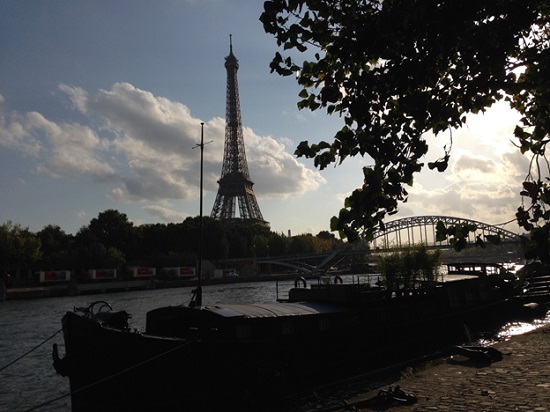
Few cities in the world evoke aromas of all the other cities you have visited the way Paris does. As James Cameron rightly said, 'Paris is an air and a scent and a state of mind’. I recently spent eight days in Paris and wandered along the myriad old alleys of this city of lights. Old is new in Paris and there is celebration of antiquity here. No skyscrapers please! Paris is one of the few remaining horizontal cities in the world. Time travels slowest in Paris. Everything here should be made at a leisurely pace, whether it is a visit to the Louvre or a lunch in a city lane. The city changes its colors like a chameleon as day slips into twilight. Paris is the most unpretentious and the most accommodative that I have visited --a city that blends with everything and yet retains its identity.
Though I had a flavor of the city back in 2003, I intended this time to explore the city in more detail and visit all significant museums and historical monuments. After all, Paris is one of the great art repositories of the world. Hence this travel note is richer in that respect than in other obvious entertainments and visual delights that the city lavishly offers. In addition to big hitting museums including the world's largest, the Louvre, there are scores of smaller but charming museums in Paris housing collections of every imaginable genre – tangible reminders of the city's illustrious artistic legacy, which endures to this day.
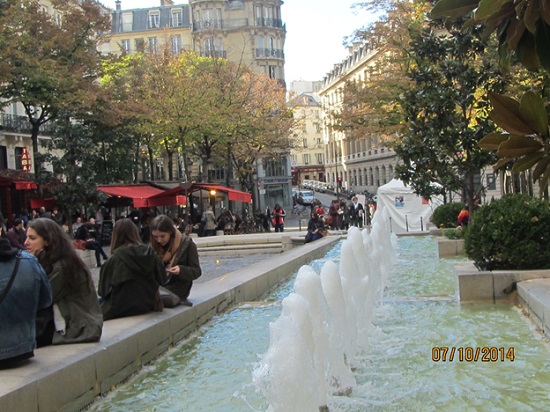
A street in Latin Quarters
I have made the following notes based on what I saw and the information gathered and the write-up follows the order in which I visited them. I have indicated the nearest Metro station wherever possible.
Musée Marmottan Monet
Nearest Metro : La Muette
This is the museum where Claude Monet's famous painting Impression,Sunrisewhich led to the impressionist movement is kept. It is located at the far end of a large town park which is about 8 minutes walk from the metro station La Muette. It has a collection of over three hundred Impressionist and Post-Impressionist works by Claude Monet ,Berthe Morisot, Edgar Degas, ÉdouardManet, Alfred Sisley, Camille Pissarro, Paul Gauguin, Paul Signac and Pierre-Auguste Renoir. More than 100 pieces of Monet (which credits the museum for the largest collection of his works in the world), donated by his son Michel, occupy a specially built basement gallery in this elegant 19th-century mansion, which was once the hunting lodge of the Duke de Valmy. Being a private museum, the Paris museum pass is not accepted here. Photography is also strictly prohibited. My suggestion is to visit the gallery of Monet's paintings first , especially the walls of the basement that adorn his stunning water Lily paintings , and then proceed to other sections of Impressionist painters (I made the mistake of going through other less interesting sections in the first and second floor).
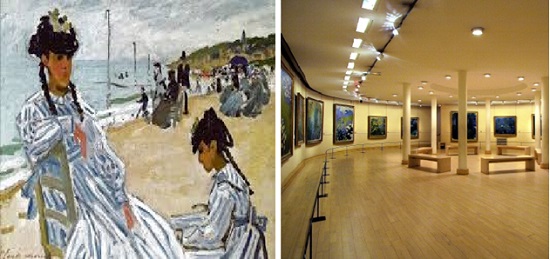
Left-Camille on the Beach by Monet. Right- the Basement hall.
Musée d'Orsay
Nearest Metro :Tuileries
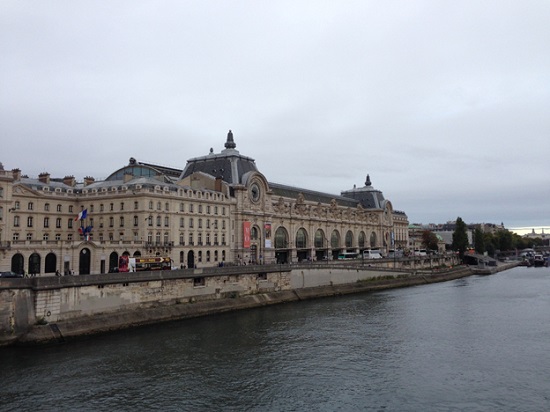
Orsay Museum on the bank of the river Seine
At the heart of Paris, on the left bank of the Seine River, opposite the Tulleries Gardens near the Louvre, stands Orsay Musem, considered the second best museum in Paris after the Louvre. It is at once exceptionally well located, housed in an extremely original building- a former train station- , and offers a collection of masterpieces of unequalled diversity. Though a relatively a new museum (Inaugurated in Dec 1986), it has one of the most beautiful Impressionist collections of over 4,000 works by artists of the late 19th century: Renoir, Monet, Van Gogh, Gauguin, Rodin, Maillol, etc.
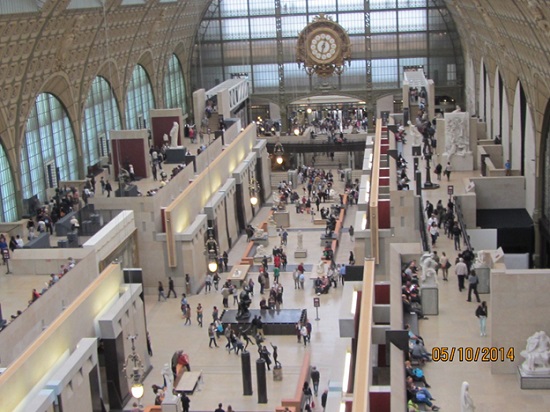
Orsay : A View from the inside
A small-scale model of the Statue of Liberty by the French sculptor Auguste Bartholdi (1834-1904)is placed at the very entrance itself. The museum is well-organized and holds separate sections for paintings belonging to different movements in art history like Classicism, Orientalism, Impressionism, Post-Impressionism, Symbolism and a lovely section devoted to Nabis. Nabis were a very cultured group of artists ( famous ones are Maurice Denis, EdouardVullard, Pierre Bonnard, Felix Valltton) who, through their widely diverse activities, exerted a major influence on the art scene in France during the late 19th century. They maintained that a work of art reflects an artist’s synthesis of nature into personal aesthetic metaphors and symbols.The Nabis were greatly influenced by Japanese woodcuts, French Symbolist painting, and English Pre-Raphaelite art.
Jardin des Tuileries (The Tuileries Garden)
Nearest Metro :Tuileries
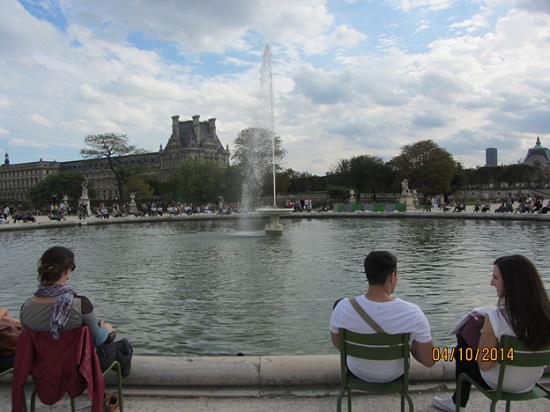
Designed the gardener of Louis XIV, this cool garden offers something for anyone who wants a respite from Paris's hustle and bustle. The lush flowerbeds in the center square, statue-studded corners, bubbling fountains and chestnut tree-lined pathways offer good oasis to recoup after your hectic visit to the three great museums located nearby- The Louvre, Orsay Museum and Orangerie.
Louvre Museum
Nearest Metro : Louvre- Rivoli or Tuileries
Most of the tourists march to this iconic museum, the largest in the world, ironically to have a glimpse of just one painting-Da Vinci’s Mona Lisa. I wonder whether over the years the Louvre has become a mere picnic spot than a place for true connoisseurs of art. The place is not a silent spot to watch or enjoy the treasure of painting /sculptures it holds.It is overwhelming and overcrowded and as such I didn't relish my tour here.
The history of the Louvre and the history of Paris are intertwined. This emblematic building has dominated the center of the city since the 12th century, changing over the years from a medieval fortress (you can still see these foundations in the basement today) to the gargantuan palace it became under the Sun King, Louis XIV, in the 17th century. Today, the Louvre is one of the world’s most important museums.
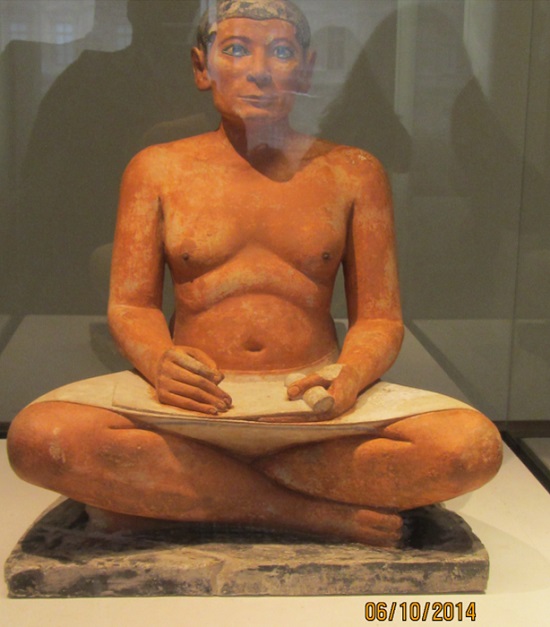
Among the many sculptures in the fascinating Egyptian section, one that captured my attention was an unusual statue named “Seated Scribe”. The "Seated Scribe", is indeed sitting cross-legged, his right leg crossed in front of his left. The white kilt, stretched over his knees, serves as a support. He is holding a partially rolled papyrus scroll in his left hand. His right hand must have held a brush, now missing. The most striking aspect of this sculpture is the face, particularly the elaborately inlaid eyes: they consist of a piece of red-veined white magnesite, in which a piece of slightly truncated rock crystal was placed. The scribe is portrayed at work, which is uncommon as I didn't see any statue bearing a pose like this in my earlier tour of Egypt.
Champs-Elysees Avenue
Nearest Metro: Champs-Élysées – Clemenceau
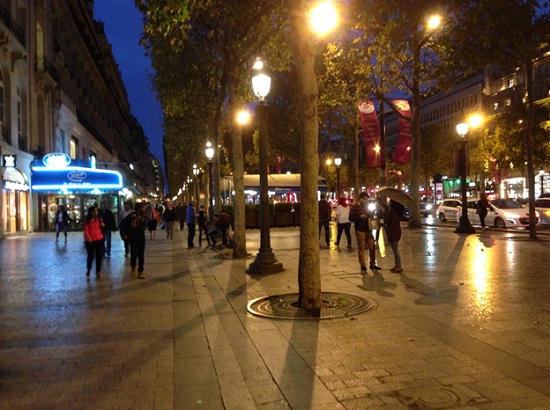
A dozen avenues radiate out from the Étoile but none is more famous than the Champs-Élysees Avenue, the world’s most famous promenade. I got out from the Metro and took a walk till I reached Arc de Triomphe. It is a delightful and charming experience to stroll along this broad, chestnut trees lined avenue past many luxury shops, period buildings, fine restaurants and even AN art cinema house-Publicis Cinema- where many Indian documentaries were listed for screening that week. The walk here is more glamorous at night and it is an excellent spot for people-watching.On my return walk, I chose to dine in a nice restaurant there.
Arc de Triomphe
Nearest Metro : Champs-Élysées – Clemenceau
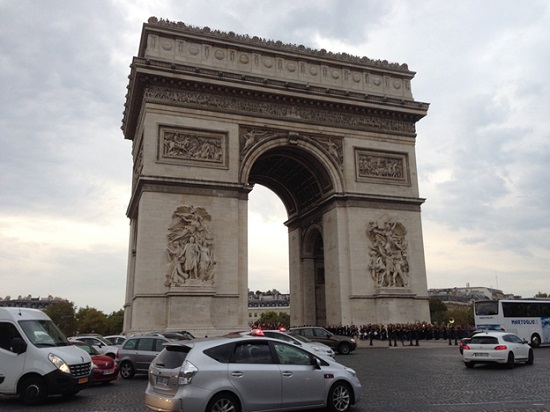
Napoleon commissioned this triumphal arch in 1806 in homage to his military victories. It is decorated with reliefs and sculptures representing scenes from his epic battles, and is the centerpiece of the place Charles de Gaulle-Etoile. Twelve majestic avenues commence at the base of the monument, most of which bear the names of famous battles fought by Napoleon.
At the western end of the Champs-Élysées, the Arc de Triomphe suggests an ancient Roman arch, only it’s larger. Actually, it’s the biggest triumphal arch in the world, about 49m high and 44m wide. To reach it, take the underground passage and never try to cross the square as it is Paris’s busiest traffic hub.
Musée de l'Orangerie
Nearest Metro: Concorde
This museum is a treat and one of the best conceived museums in Paris. Wonderfully modern and bright, it has Monet's Nymphéas (Waterlilies) in all their splendor exhibited in two huge oval rooms purpose-built in 1927 on the artist's instructions. Words cannot express the deep serenity that comes from viewing Monet's Water Lilies series in person. The painting by itself creates a view of infinity in the eyes of the beholder, not being able to distinguish between the sky from the lake. These dazzling, huge pieces were created as panels that were sewn together, four each presented in each of the oval rooms. During the day the natural light comes in from a window in the ceiling. It is as Monet himself mentioned a “haven of peaceful meditation”, a gift to modern man with his “overworked nerves”. Orangerie is a shrine to Monet and his beloved waterlilies: anyone lucky enough to be alone with the Nymphéas is invited to meditate, perchance to dream.
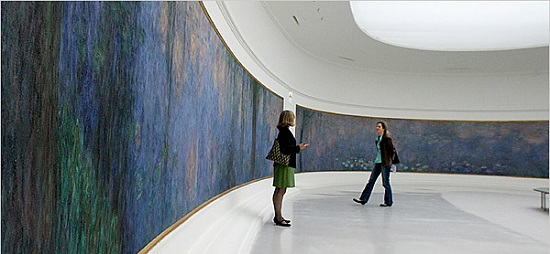
Works ofother impressionist painters and other artists such as by Cézanne, Matisse, Picasso, Renoir, Sisley, Soutine and Utrillo complete the gallery's outstanding playlist.
Notre-Dame Cathedral
Nearest Metro: St-Michel
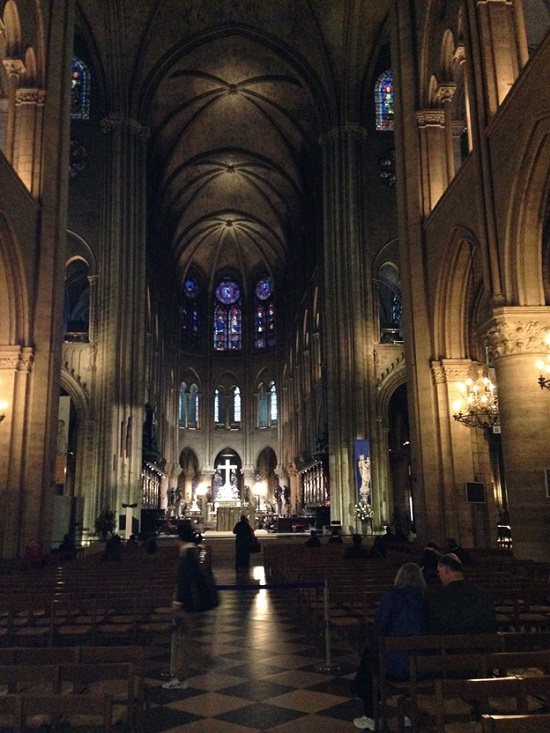
Interior of Notre-Dame Cathedral
What surprises anyone entering this great cathedral built in 14th century is its sublime balance from the inside. It is exactly what you'd expect - massive, elaborate, awe-inspiring, moving - and more. Just taking a moment to sit under the high ceilings and stained-glass windows is indeed a divine experience. The work on Notre Dame was begun in 1163 and largely completed by the early 14th century. The cathedral was badly damaged during the Revolution and was renovated between 1845 and 1864. Its magnificent forest of ornate flying buttresses that encircle the cathedral chancel and support its walls and roof are a spectacle in itself.
Just imagine! In the early nineteenth century, this cathedral was in such a state of disrepair that the city considered tearing it down. Luckily for us, Victor Hugo heard about the plans to destroy it and wrote The Hunchback of Notre-Dame to raise awareness of its glorious history.
Musee National du Moyen Age (known earlier as Musee de Cluny)
Nearest Metro: Cluny La-Sorbonne
Medieval history comes to life at France's Musée National du MoyenÂge located in Latin Quarters. This National Museum of the Middle Ages is often referred to as the Musée de Cluny due to the fact that it's partly housed in the 15th-century Hôtel de Cluny, Paris' finest civil medieval building.
The museum brings together an incredibly rich collection of art and artifacts of the Middle Ages, mostly from France, in a setting that includes an ancient Roman bath. Illuminated manuscripts, weapons, suits of armour, and objects of made of gold, ivory and enamel are grandly displayed here. However, the main attraction here is The Lady and the Unicorn tapestries, a sublime series of late15thcentury tapestriesfrom Southern Netherlands, the most acclaimed tapestries of their kind. Among other riches here are the stone heads of French kings from the facade of Notre Dame, a collection of restored stain glass from Ste. Chapelle, several retables, and a superb collection of carved ivory Biblical scenes.
A little more need to be said about the tapestries here which makes Cluny museum unique in the world. All the romance of the age of chivalry—a beautiful princess and her handmaiden, beasts of prey, and house pets—lives on in the remarkable yet mysterious tapestries discovered only a century ago in Limousin’s Château de Boussac.
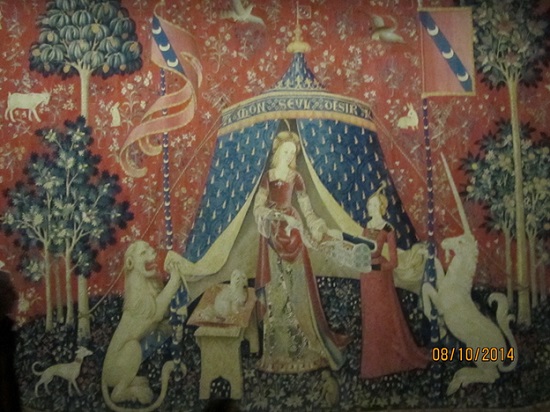
The famous Lady and the Unicorn Tapestry
Each of the six separate hangings features a slim, blonde woman with a unicorn to her left and a lion to her right. Their exact provenance remains a mystery, though they are believed to have been commissioned by a member of the prosperous and noble Le Viste family in the late 1400s and created from designs, or "cartoons", drawn in Paris.Five seem to deal with the senses (one, for example, depicts a unicorn looking into a mirror held by a dour-faced maiden). The sixth shows a woman under an elaborate tent with jewels, her pet dog resting on an embroidered cushion beside her, with the lovable unicorn and his friendly companion, a lion, holding back the flaps.
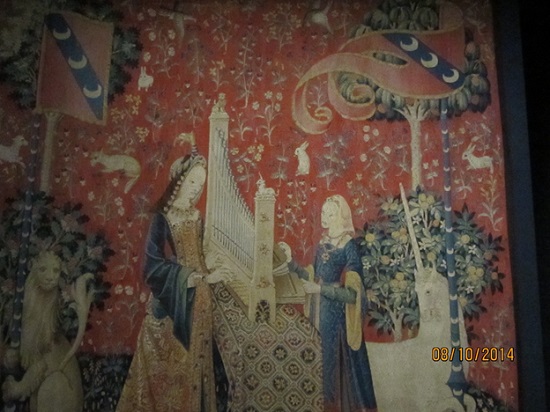
The red background of each tapestry is strewn with a rich variety of flowering plants and features pine, orange sessile oak and holly trees, the repeated motif of a coat of arms of three white crescents on a blue background, and animals including numerous rabbits, goats, dogs, lambs, monkeys and birds.
These tapestries have inspired novels and songs, featured in Harry Potter movies and puzzled historians for the best part of 500 years. The Lady and the Unicorn is regarded as the Mona Lisa of woven artworks, one of the greatest surviving artefacts of its kind from the Middle Ages.
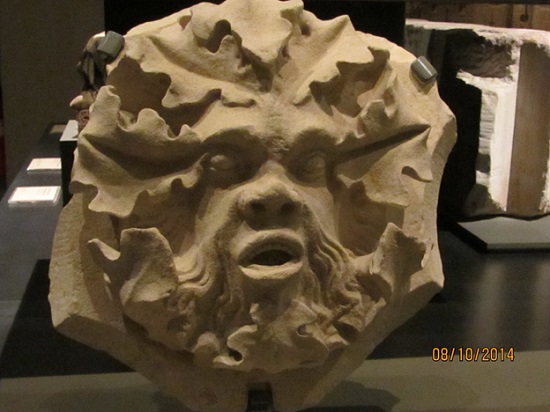
Keystone Mask: 13th Century
The other exhibits mainlyrevolve around Christianity : Flemish retables; a 14th-century Sienese John the Baptist and other sculptures; statues from Sainte-Chapelle (1243–48); 12th and 13th-century crosses, chalices, manuscripts, carvings, vestments, leatherwork, jewelry, and coins; a 13th-century Adam; and recently discovered heads and fragments of statues from Notre-Dame de Paris. In the fan-vaulted medieval chapel hangs another set of tapestries depicting scenes from the life of St. Stephen (Audio guide will help to understand stories depicted in the tapestries).
Panthéon
Nearest Metro: Maubert - Mutualité
The Panthéon is a fine example of 18th-century neoclassicism. Built as a church and completed the year the Revolution broke out, this sublime neoclassical structure now serves as a mausoleum for great men of the era of French liberty (Victor Hugo, Voltaire, Rousseau, Soufflot, Zola , Alexander Dumas and Braille are some of the luminaries buried here), though in 1995 it welcomed its first woman, Nobel Prize-winner Marie Curie, who was reburied here along with her husband, Pierre.
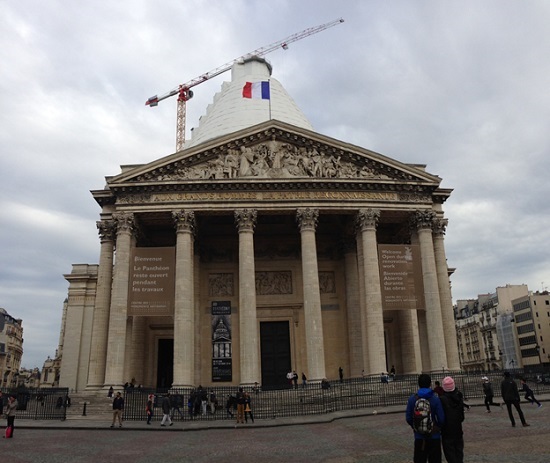
Panthéon
In 1744, Louis XV vowed that if he recovered from a mysterious illness, he’d builda church to replace the Abbaye de St-Geneviève. He recovered but took his timefulfilling his promise. It wasn’t until 1764 that Mme. de Pompadour’s brother hired Soufflot to design a church in the form of a Greek cross with a dome reminiscentof St. Paul’s in London. When the architect Soufflot died, his pupil Rondelet carried out the work, completing the structure 9 years after his master’s death.After the Revolution, the church was converted to a “Temple of Fame” and became a pantheon for the great men of France.
The overall design was that of a Greek cross with massive portico of Corinthian columns. Its ambitious lines called for a vast building 110 metres long by 84 metres wide, and 83 metres high. No less vast was its crypt. Soufflot's masterstroke is concealed from casual view: the triple dome, each shell fitted within the others, permits a view through the oculus of the coffered inner dome of the second dome, frescoed by Antoine Gros with The Apotheosis of Saint Genevieve. The outermostdome is built of stone bound together with iron cramps and covered with lead sheathing, rather than of carpentry construction, as was the common French practice of the period. Concealed flying buttresses pass the massive weight of the triple construction outwards to the portico columns.
In 1851, physicist Léon Foucault demonstrated the rotation of the earth by his experiment conducted in the Panthéon, by constructing a 67 metre Foucault pendulum beneath the central dome.
The dome of the Pantheon is currently under renovation and hencemy overall impressionabout this monument was a bit subdued.
Jardin du Luxembourg (The Luxembourg Garden)
Nearest Metro location: Luxembourg
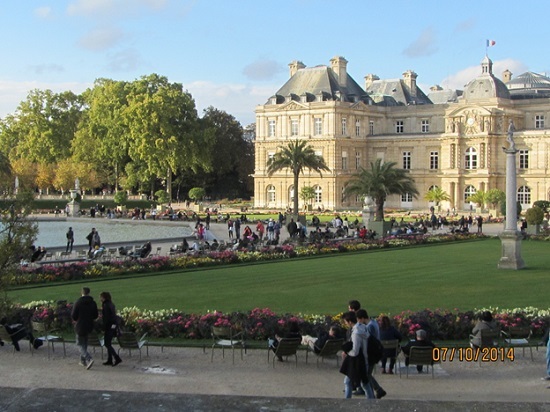
This beautiful Garden is located at walking distance from Pantheon. It was the first French garden to be influenced by the Italian Baroque. The gardens, and the palace, were begun in 1612. The Luxembourg has long been seen as a quintessential Parisianspace and remains very popular with Chestnut groves and lush lawn. It is a pleasure to spend an evening here and it harbors over a hundred sculptures, including statues of Stendhal, Chopin, Montesquieu, Phidias, Baudelaire, Delacroix and Blanche of Castile.. Hemingway used to walk through the gardens on his way to visit renowned patron of the arts Gertrude Stein.
Eiffel Tower
Nearest Metro location: Bir-Hakeim
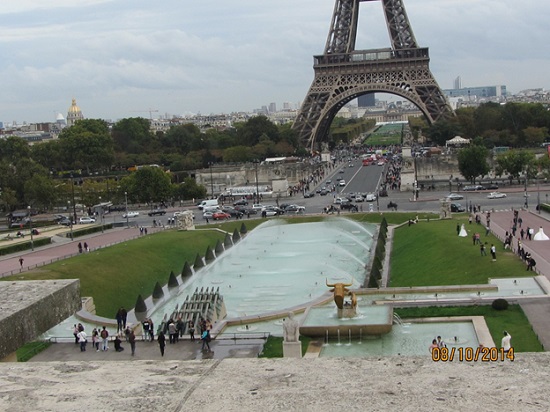
The view of fountain in front of Eiffel Tower
Visiting this landmark monument is a ritual for any tourist. It is indeed quite impressive from a distance and offers the greatest cityscape view in Europe.Eiifel Tower is an iron lattice tower built in 1889 by Gustave Eiffel for the 1889 World's Fair and located on Champ de Mars. At 324 metres it is the tallest building in Paris and one of the most visited monuments in the world. Since climbing to its top requires queuing for hours, I didn’t make an attempt this time.
Sainte-Chapelle
Nearest Metro location: St-Michel
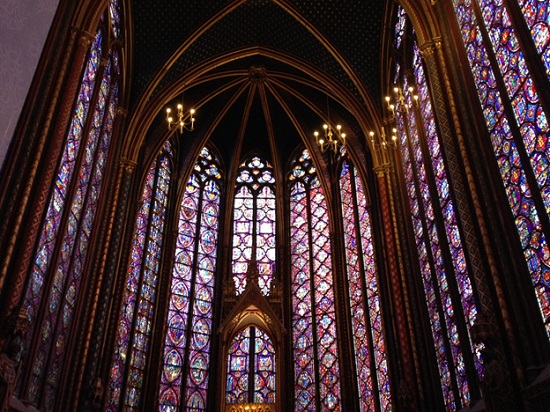
Located near Notre-Dame Cathedral, this is one of the most beautiful chapels in France.This medieval monument was built to house Christ’s Crown of Thorns, which King Louis IX (Saint Louis) bought from the emperor of Constantinople in the 13th century.
Sainte-Chapelle has two sanctuaries, one on top of another. In the lower one, the visitors are greeted by a statue of Virgin Mary, the patron saint of the sanctuary. The upper chapel is a truly monumental and sumptuously decorated reliquary. Sculptures and windows combine harmoniously to glorify the passion of Christ. The 1113 scenes depicted in the 15 stained glass windows tell the story of mankind from genesis through to Christ’s resurrection. Considered a veritable masterpiece of Gothic architecture, the 600 sq. m of magnificent curtain like stained-glass windows are a delight to the soul. The architecture is so delicate that when you are inside the church, you feel as if you are in a palace entirely constructed of colored glass.Ste-Chapelle is at its most dazzling when the sun is shining and the glass flickers in a glorious rainbow of colors.
Rodin Museum
Nearest Metro location: Varenne
The lovely Musée Rodin is the most romantic of Paris' museums. Auguste Rodin's former workshop, the 1730-built HôtelBiron, is filled with masterpieces like the marble monument to love, The Kiss , as well as works by his muse and protégé, sculptor Camille Claudel, and by other artists including Van Gogh and Renoir. The real treat, though, is the mansion's rambling sculpture garden, which provides an entrancing setting for contemplating works like The Thinker.
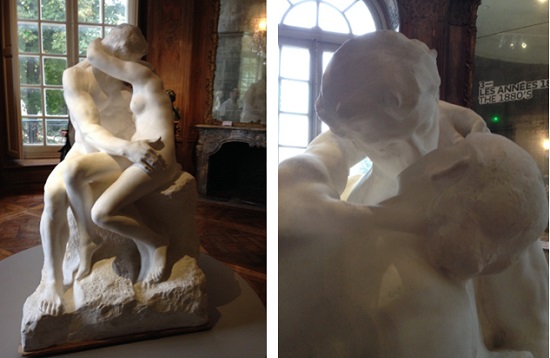
The Kiss by Aguste Rodin
When conceived in 1980as the crowing element of The Gates of Hell(based on Divine Comedy),The Thinker statue was only 70 cm high.It was originally titled The poet, representing Dante, the author of the Divine Comedy which had inspiredThe Gates, leaning forward to observe the circles of Hell, while meditating on work. Enlarged in 1904, its colossal version, installed in the front garden of Rodin museum, is more popular as the image of a man lost in thought, but whose powerful body suggests a great capacity for action.
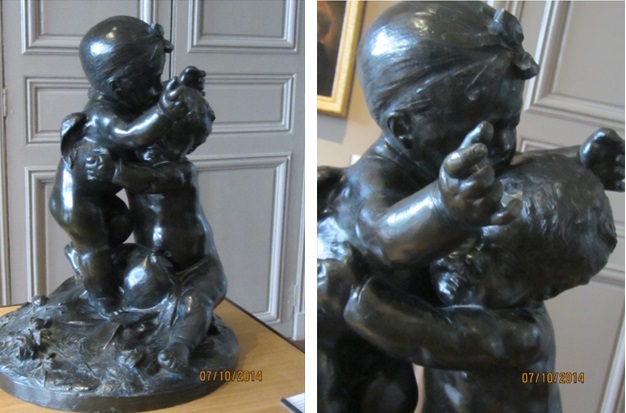
Ixelles Idyll by Auguste Rodin
I was exceedingly attracted to the sculpture “Ixelles Idyll”. This was designed by Rodin while living in Belgium. It is a cherub and a young child-both plump and chubby –cheeked, embracing each other on a wide plinth scattered with flowers. It has no theme other than innocent happiness
Musée de l'armée–Invalides
Nearest Metro :Varenne
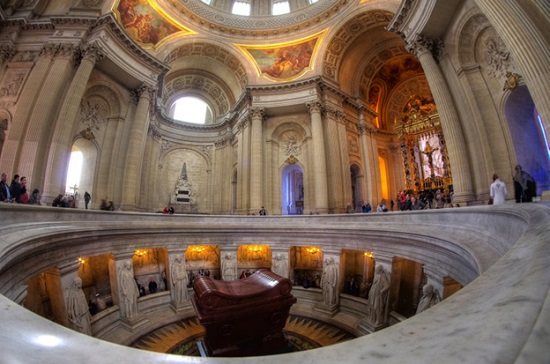
The tomb of Napoleon
I saw the huge dome of this museum as I got out of the Metro Verene to visit Rodin Museum. I had no initial plan to visit it. But, being near to Rodin Musem and captivated by the massive building, I visited it and to my surprise I realized this museum is also home to the tomb of the Emperor Napoleon.
The Musée de l'Armée, created in 1905, is located in the prestigious setting of the Hôtel National des Invalides. It was created just after the World Fair and is the result of the merger of the Muséed'Artillerie, opened in 1796, and the old Musée de l'Armée created 100 years later. It is made up of a museum and two churches with some 500,000 classified objects, spread over 8 000 m². These objects make this museum the most important museum of military history in France, and one of the leading ones in the world. So if you have an army man in your family, he is certainly going to like this museum.
The museum is a real military pantheon, containing the tomb of the Emperor Napoleon I, the tombs of his brothers Joseph and Jérome Bonaparte, his son and many generals.
Musee National des Arts Asiatiques – Guimet
Nearest Metro :Iena
Founded in 1879 by ÉmileGuimet, a wealthy industrialist from Lyon, this is the most impressive museum I have visited in Paris. No one interested in art should miss this museum where each artifact holds a surprise and invites multiple viewing. This is one of the most beautiful Asian museums anywhere, at least in my experience. The sheer immensity of each hall and the way the sculptures are placed and presented can’t be praised enough. The Budhisttava images from Cambodia, Vietnam, Burma, China, Japan and India form majority of the collections here. There is also a wonderful collection of sculptures from India. The Chinese section is also equally impressive.
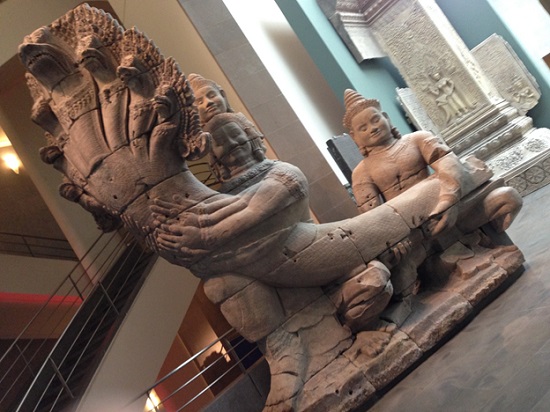
Naga statue from Angkor Wat
A huge sculpture of a seven-headed Naga (Sepent) from Angkor WatinCambodia placed at the entrance. Ranging from the Buddhas from Afghanistan to the Zen monks of Japan, from Indian fabrics to Samurai armour, and from Khmer treasures to Chinese fine art, the MuséeGuimet offers unique collections which provides the opportunity to go on a meditative, aesthetic and explorative journey to the heart of Asia.
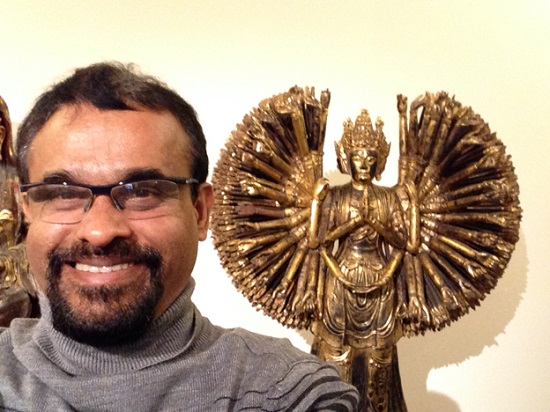
Magnificently renovated in contemporary style, this museum is a veritable feast for the eyes, especially if you are interested in sculptures. The audio guide, which comes free, helps to understand the origin and context of the sculptures.
Muséed'ArtModerne de la Ville de Paris (Modern Art Museum of Paris City)
Nearest Metro :Iena
If you are visiting Musee National des Arts Asiatiques – Guimet, this one can be combined along with that as it is situated close by.

The mother and the Infant by Wilhelm Lehmbruck Portrait of Martial Raysse by Klein
Housed in the Eastern Wing of the monumental Palais de Tokyo, the permanent collection at the city's modern-art museum displays works representative of just about every major artistic movement of the 20th and nascent 21st centuries. This museum opened in 1961 is home to works of modern art, including Henri Matisse’s The Dance, Pierre Bonnard’s Nude in the Bath and The Garden, and Fernand Léger’s Discs. There are also works by Chagall, Rothko, Chaime Soutine, Braque, Dufy, Picasso, Utrillo, and Modigliani. The museum also presents excellent sculpture collections like The mother and the Infant by Wilhelm Lehmbruck and Yves Klein’s Portrait of Martial Raysse and ever-changing exhibits on individual artists from all over the world on contemporary international trends.
Unlike other museums, this one is less visited and hence it is a pleasure to go around and enjoy many trends in modern art like Fauvism.
Japanese Garden of The Buddhist Pantheon
Nearest Metro :Iena
This is located in the same street as that of Musee National des Arts Asiatiques .With its giant bamboo, flagstones, small wooden bridges and pond, it is one of the most “Zen” places in the heart of Paris, a true haven of peace and tranquility.
You will also find a lovely lodge created by Japanese artists and carpenters. It hosts the tea ceremonies of Guimet Museum, which offer an ideal time to discover the pleasures of the art of living in Japan.
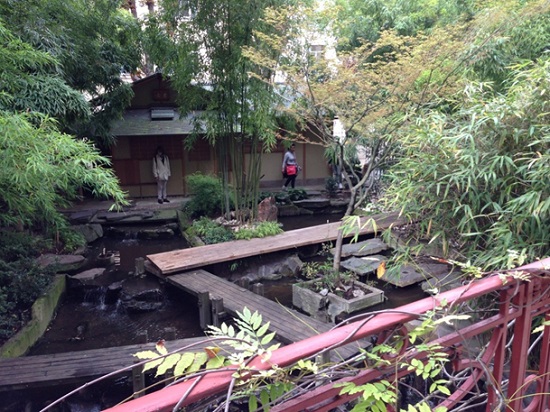
After enjoying the peaceful atmosphere of the garden, I took a walk through the brief collections of the Buddhist Pantheon in the adjacent museum.
Centre Pompidou
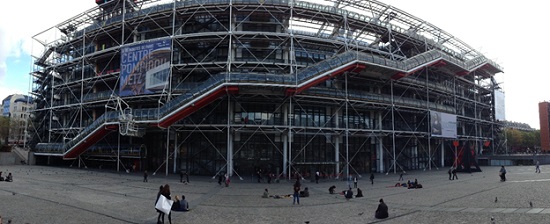
A Panoramic shot of Centre Pompidou
Love it or hate it, the Pompidou is certainly the city’s most avant-garde building. Most Parisians have warmed to the industrial plant like exterior that caused a scandal when it opened in 1977. Critics called it as a “wart” on the face of Paris (I nod to that). Named after French president Georges Pompidou (1911–74), it was designed by then-unknowns Renzo Piano and Richard Rogers. The architects’ claim to fame was putting the building’s guts on the outside and color-coding them: water pipes are green, air ducts are blue, electrics are yellow, and things like elevators and escalators are red. Art from the 20th century to the present day is what you can find inside. It is a citadel of modern art, with exhibitions drawn from more than 40,000 works.
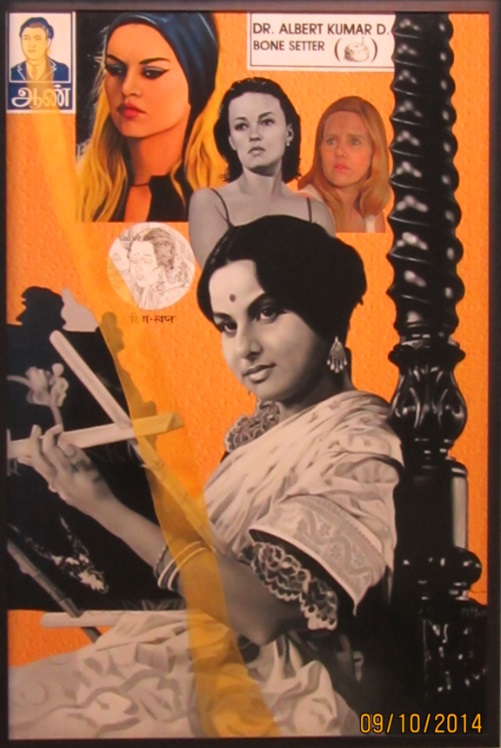
Femmes du monde: Indian Painter AtulDodiya’s Charulatha (Satyajit Ray)
When I visited, a special exhibition of the works of Marcel Du Champ (famous for his work Mona Lisa with Moustache )was on display. You may note that Museum pass doesn’t cover special exhibitions and you need to pay extra to visit them.
Musée du quai Branly
Nearest Metro: Alma -Marceau
If you are visiting Paris with your children, you must visit this enchanting museum that possesses some very distinctive features in its exterior and interior. No other museum in Paris provides such inspiration for travelers, armchair anthropologists and those who simply appreciate the beauty of traditional craftsmanship. A tribute to the incredible diversity of human culture, the Musée du Quai Branly presents an overview of indigenous and folk art from around the globe.
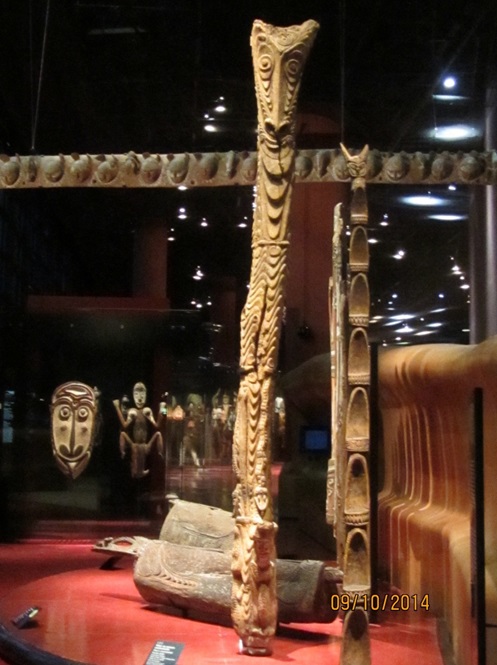
The architect Jean Nouvel wanted to create something, “unique, poetic, and disturbing.” And so he did with this $265-million museum, which opened in 2006. Set in a lush, rambling garden on the Left Bank in the shadow of the Eiffel Towerthis museum houses nearly 300,000 tribal artifacts from Africa, Asia, Oceania, and the Americas. Galleries stand on sculpted pillars that evoke totem poles.
No other museum in Paris provides such inspiration for travelers, armchair anthropologists and those who simply appreciate the beauty of traditional craftsmanship. A tribute to the incredible diversity of human culture, the Musée du Quai Branly presents an overview of indigenous and folk art from around the world.
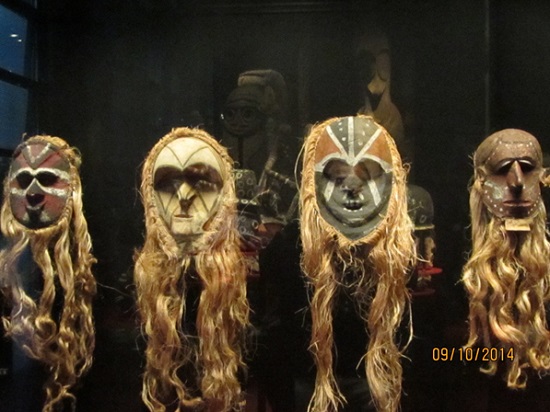
The museum showcases an impressive array of tribal masks, funeral poles, carvings, weapons, jewelry and more from different cultures andcivilizations like Yoruba, Mayas, Aztecs and Incas , all displayed in a refreshingly unique interior without rooms or high walls. Some of these totems and masks are so lifelike and emotional in their creation that they can evoke the fear and elation, which is accentuated by dim lightsand eerie music played in the halls.
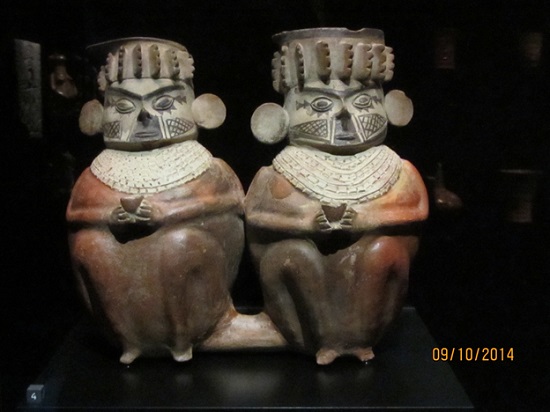
There are some masks from India too. But to my disappointment, I didn’t find any Kathakali or Theyyam masks that could have added resplendence and grandeur. The only thing I didn’t like here is that certain pieces are not arranged thematically. For example, I found a Bodhisattava statue squeezed in the section exhibiting tattoo scenes from different cultures.
Bibliothèquenationale de France
Nearest Metro :Bibliothèque François Mitterrand
Imagine a rectangular space with four open books placed at four corners of the rectangle and that is what this great library and exposition Centre looks like. The French National Library was opened in 1996 with a futuristic design by Dominique Perrault: the library is built into four 24-story towers each symbolizing the image of an open book. This was the last of the grandprojects of the late François Mitterrand. It boasts of the nation’s literary and historic archives and is regarded as a repository of the French soul. This is something worthy of a nation that gave birth to some of the greatest philosophers and luminaries of human history like Voltaire, Montaigne, Pascal, Roland Barthes, Michel Foucault, Henri Bergson, Claude Lévi-Strauss and Jean Paul Sartre. The library incorporates space for 1,600 readers at a time, many of whomenjoy views over two levels of a garden-style courtyard that seems far removed from Paris’s urban congestion.
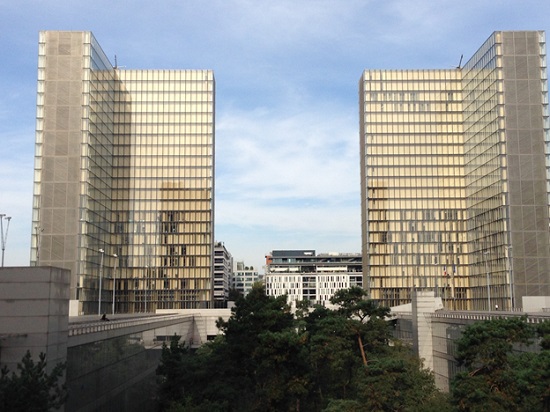
The 24 storied glass towers shaped like an open book
This is one of Europe’s most user-friendly academic facilities, emphasizing computerized documentation and microfiche—a role model that will set academic and literary priorities well into the future. The public has access to as many as 180,000 books, plus thousands of periodicals, with an additional 10 million historic (including medieval) documents available to qualified experts. The visitors can attend lectures and expositions paying an entry fee.
Musee de l'Erotisme (Museum of Eroticism)
I concluded my Paris tour with my visit to this fascinating museum. I stayed at hotel Royal Fromentin located near the metro Pigalle and this museum was just 3 mts walk from my hotel. The only confusing aspect of its location is that it is nestled in the midst of a series of shops in the street and its exterior doesn’t give the impression of a museum. A tribute to the primal appeal of human sexuality, this art gallery/museum is in a 19th-century town house that had been a raunchy cabaret.
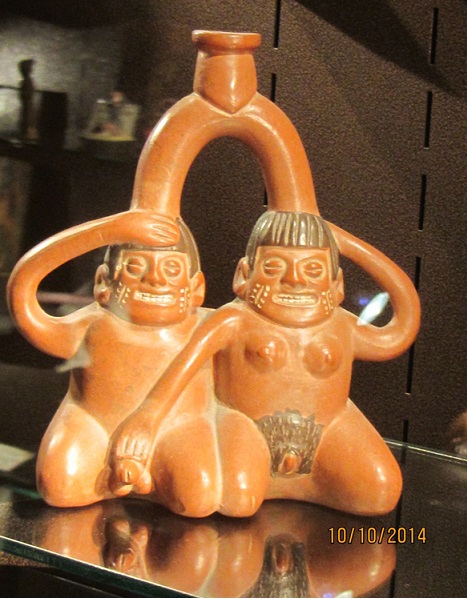
However, it is quite fascinating and this seven-story museum houses a tasteful but risqué collection of erotic artifacts from Africa, South America, China and India such as sculptures, figurines, paintings, pottery, miniatures, photography and much more like screening monitors showing oldest erotic films.
I never knew that cultures like Incas and Mochikas had a well-developed erotic art tradition like in India.
Concluding Note
Paris is a fabulous tourist friendly city. In general, I found all parts of Paris safe for travel. If you are intending to visit museums, I would strongly recommend to get Museum pass at any Tourist Information outlet. This avoids long queues for tickets and makes possible multiple visits to museums. The Paris metro and public transport pass known as ‘Paris Pass’ can also be obtained at Information counter. Most of the tourist attractions are located nearby metro stations and hence I hardly used any other means of transport. Reasonable 3 star accommodations that includes breakfast near a metro station could cost anything from 120-150 Euro per night. I stayed near Blanche metro station where the famous show Moulin Rouge is located. Consider 25-30 Euro for a decent lunch with a glass of wine. Paris is a gourmet’s city; so do spare some dimes to dine at fine restaurants located in all the alleys of Paris.
What I experienced in Paris during my eight days is best summarized by Margaret Anderson,
“Paris is the city in which one loves to live. Sometimes I think this is because it is the only city in the world where you can step out of a railway station—the Gare D’Orsay—and see, simultaneously, the chief enchantments: the Seine with its bridges and bookstalls, the Louvre, Notre Dame, the Tuileries Gardens, the Place de la Concorde, the beginning of the Champs Elysees—nearly everything except the Luxembourg Gardens and the Palais Royal. But what other city offers as much as you leave a train?”
09-Nov-2014
More by : P. G. R. Nair